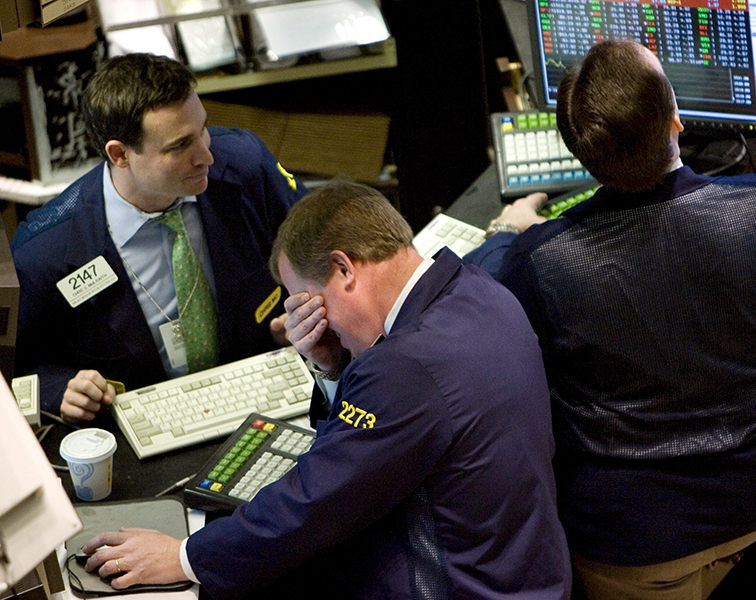The “R” word is being used more and more as recessionary winds start blowing more loudly through economic data and the price actions across the asset class spectrum. On Friday, US manufacturing and industrial production data were soft. That follows weaker US retail spending and housing market data previously. Even oil prices cracked under the weight of recession noise. A classic case perhaps, of high prices being the best cure for high prices?
US yields eased lower in response as well, but not by much. The US Dollar remained firm while US equities had a mixed session. The Dow Jones edged lower while the S&P 500 edged higher, but the Nasdaq jumped by over 1.40%. One could argue that a recession in the US means less tightening, a boon for the interest-rate-sensitive Nasdaq. But as I mentioned last week, there were a galactic amount of options expiries on US equity markets on Friday, so take the price action with a grain of salt. A US holiday today will keep volumes thin.
In China today, iron ore, steel rebar and coal futures have all plummeted as local markets join the US ones in pricing in a slowdown. Chest thumping over the weekend by China around the Taiwan Strait, and legislation allowing Russian-style “special operations” won’t be giving regional Asia much comfort either.
You can choose from an extensive drop-down menu of recessionary drivers. Rising inflation and interest rates in the developed world, the Ukraine-Russia war and ensuing commodity disruption, the covid-19 slowdown in China, and the list goes on. It is clear that sentiment is turning though and given the appalling track record of forecasting these past couple of years, the more central banks say, “soft landing,” the more nervous markets become, and rightly so.
Unfortunately, with all your monetary bullets fired and stagflation at your doorstep, as a central bank you don’t have any pleasant choices. Do nothing, and inflation continues to rise, but growth may not; expect protests on the streets. Hike rates to dampen inflation but with growth already slowing or falling, you know how the story ends. The best I see it is that the recession, when it arrives, is short and sharp and, at least in much of the developed world, it’s starting from a relatively high base.
Asset price volatility is an inevitable consequence as the street tries to price in the next direction of travel. Currency markets are saying the Fed won’t blink on rates. Bond markets are saying that to, although is US 1-years drop back below 3.0%, then perhaps they are wavering. Gold doesn’t seem to care. Oil is cracking like a refining spread, but has yet to reach my longer-term support lines, although we’re not far away. It would be ironic if falling energy prices from a recession torpedoed the funding for Vladimir Putin’s war machine.
Nowhere has been more frantic than the crypto space which endured some emotional volatility over the weekend as expected. Bitcoin fell 15-odd per cent on Saturday as support at $20,000.00 cracked, finishing 7.50% lower for the day at $18,955.00. It rallied yesterday by 8.40% to $20,550.00, only to fall 3.50% this morning after another Solend Labs, which allows you to lend or borrow in something called Solana, granted itself emergency powers to take over a (very) large account to manage its exposure. The more the merde hits the fan in the DeFi space, the less decentralised it seems to be becoming as reality bites. I can’t help but think of George Orwell’s Animal Farm. “All animals are created equal, but some are more equal than others.”
That said, the price action on Saturday looked very much like forced margin stop-outs triggered by the failure of the $20,000.00 support level. Yesterday’s price action suggests that as well. I don’t rule out a rally by cryptos this week as enough lambs appear to have been silenced for now. Equity markets in the real world may also have had the herd thinned enough temporarily.
Leaving central bank-induced speculative exuberance-based digital Ponzi schemes behind, for now, the week is somewhat thin on tier one data. China has left its One and Five-year Loan Prime Rates unchanged today and may have added fire to the local market commodity price falls. Markets appear disappointed that no stimulus crumbs were thrown to the markets, even a 5 or 10 basis point trim of the 5-year LPR. I still contend that China’s biggest short-term threat is more covid-19 lockdowns. I’ll say it till I’m blue in the face, China is unlikely to be “one and done,” and the virus only has to get lucky once under covid-zero.
Elsewhere in the Asia-Pacific, tomorrow’s Reserve Bank Of Australia Minutes is released tomorrow, with markets picking over the carcass searching for any clues on the direction of RBA interest rate policy. How high, and for how long, will rates move higher? Friday’s Japan Inflation Rate will have more interest than any time over the last 20 years I expect as the Bank of Japan defied the word and maintained super-easy monetary policy last Friday.
We received a swath of PMI data from across the globe on Thursday. The US calendar sees New Home Sales tomorrow and Existing Home Sales on Friday. Both have downside risks and may add to the recessionary noise. The week’s highlight is likely to be testimony from Fed Chairman Jerome Powell on Wednesday and Thursday. But we also have a plethora of Fed speakers throughout the week as well. With a dearth of tier-1 data, Fed speakers are likely to drive intraday volatility, although it wouldn’t surprise me that after last week’s bonfire, risk assets in general consolidated higher this week. Either way, we can expect plenty of intraday noise, but ultimately directionless volatility this week in my opinion.
Asian equities start the week lower.
Asian markets are off to a weak start as the recessionary fears sweeping the US on Friday, continue to weigh on sentiment in Asia. For once Asian markets are not moving in lockstep with the US ones, and I put that down to the distortions of options expiries on Wall Street on Friday. The S&P 500 closed up just 0.22% on Friday, but the Nasdaq leapt 1.43% higher, while the Dow Jones edged 0.16% lower after soft US Manufacturing and Industrial Production data. In Asia, US futures are rising, although with it being a US holiday today, I am not placing too much emphasis on the price action. S&P futures are 0.17% higher, Nasdaq futures are 0.50% higher, while Dow futures are unchanged.
Another outperformer is China, which is well and truly bucking the trend in Asia today. Mainland China markets have reversed sharply higher after China left its 1 and 5-year LPRs unchanged, a counterintuitive move. News that Shenzhen has apparently locked some neighbourhoods in virus curbs should also be a headwind. Nevertheless, the Shanghai Composite is now unchanged, but the CSI 300 has risen by 0.65%, with Hong Kong’s Hang Seng edging 0.15% higher. The price action looks to be “buy at worst” and “smoothing.”
Over in Japan, the Nikkei 225 has fallen by 1.0%, with South Korea’s Kospi slumping by 2.20% today. Taipei is 1.10%, with Singapore remaining unchanged. Kuala Lumpur has lost 1.25%, while Jakarta id 0.90% lower, and Bangkok and Manila have eased by 0.10%. In Australia, falling China resource prices have pushed the ASX 200 down by 0.45%, with the All Ordinaries losing 0.65%.
After such a torrid week last week, a corrective bounce by equity markets cannot be ruled out this week. However, that may have to wait for another 24 hours as US markets are closed today. With nothing on the calendar of note today, European markets may take some solace from lower energy and commodity prices, although European natural gas supplies are tighter than ever as Russian flows reduce.
For US markets, the plethora of Fed speakers this week, including a double-header from Jerome Powell, are likely to drive intraday volatility in the absence of many tier-1 data releases.
US Dollar remains firm but choppy
The US Dollar held onto its intraday gains on Friday, as US bond inflows seemed to support it as investors preferred safety over risk into the weekend and today’s US holiday. With the weekend being relatively uneventful, the US Dollar has eased in Asia, but overall continues a pattern of choppy range trading. The dollar index rose 0.82% to 104.65 on Friday, thanks mostly to a weak yen. In Asia, it has eased 0.26% to 104.38. The dollar index has support at 1.0350 with resistance now distant at 1.0570.
EUR/USD eased by 0.56% to 1.0495 on Friday in another 100-point session, climbing by 0.31% to 1.0525 in Asia as weekend hedges are taken off. Dutch natural gas futures prices remain elevated, so the single currency is not receiving much of a boost from last Friday’s oil retreat. It has initial resistance at 1.0600, with challenging resistance at 1.0650. Support is at 1.0450 and 1.0400 now although I note that EUR/USD has based twice at 1.0350. That leaves the door open slightly to a corrective recovery this week.
Sterling has another awful day as its economic picture darkens, falling by 1.10% to 1.2215 on Friday, edging 0.22% higher to 1.2240 in Asia. GBP/USD has initial resistance at 1.2400 and 1.2500, with support at 1.2200 and then 1.1950.
USD/JPY powered higher on Friday as the Bank of Japan left monetary policy unchanged and continues to heavily intervene to cap ultra-low JGB yields. With Japan’s inflation only expected to hit 2.50% this Friday, I can’t really blame them, but with the US, Switzerland, the United Kingdom, et al hiking, the interest rate differential continues to power USD/JPY higher. USD/JPY leapt 2.10% higher to 135.00 on Friday, with last week’s 131.50 low a distant memory and a bargain for somebody. Having probed 135.45 today, USD/JPY has eased back to 134.85 this morning, as commodity prices fell. It is likely to be only a respite though as unless US yields move sharply lower this week. USD/JPY has resistance at 135.60with support distant at 132.20.
Swings in investor sentiment continue to generate all the two-way volatility in the Australian and New Zealand Dollars. AUD/USD fell 1.60% on Friday to 0.6935 before rising to 0.6955 in Asia. NZD/USD fell 0.80% to 0.6315 on Friday before rising to 0.6330 in Asia. A US holiday is dampening volumes but both Australasians have traced out bottoming patterns on the charts. As long as 0.6850 and 0.6200 hold respectively, further gains to 0.7150 and 0.6450 cannot be ruled out.
On a 24-hour basis, Asian currencies are mostly unchanged today after the losses on Friday, and were mostly unwound this morning. The main reason has been a rally by China’s CNY and CNH after the PBOC left both the 1 and 5-year LPRs unchanged. USD/CNY has fallen 0.60% to 6.6760, while USD/CNH has fallen by 0.50% to 6.6745, dragging USD/Asia lower. Although the KRW, INR, MYR, THB, and IDR look the most vulnerable and remain near last week’s lows, a US holiday today should mean range-trading continues into Wednesday.
Oil slumps on recession fears.
Oil prices plummeted on Friday as increasing recession fears after soft US Manufacturing and Industrial Production data saw a mess sell-off in futures markets. Brent crude fell by 5.0% to $113.15 a barrel, but WTI plummeted by 6.0% to $110.00 a barrel. In Asia Brent has edged 0.25% lower to $112.85, while WTI has fallen by 0.75% to $109.20 a barrel.
Looking at the price action, I am undecided whether Friday’s capitulation is the start of a repricing of oil lower as the world economy slows dramatically in the months ahead, or whether it was a capitulation of extended speculative long positioning in the futures markets. Chinese Customs reported record oil imports for May this morning, suggesting demand remains as strong as ever. That remains so around the world, and the squeeze on refined products like diesel and gasoline remain as tight as ever.
Friday’s falls have bought my six-month support lines back into focus. On Brent crude, that is at $107.00 a barrel today, just below its 100-day moving average (DMA) at $107.95. Ahead of this, it has support at $112.00, with resistance at $114.25 and $116.00 a barrel. WTIs six-month support line is at $106.00 a barrel, just ahead of its 100-DMA at 105.00. It has interim support at $108.25, and resistance at $112.50 a barrel.
Of the two, WTI looks the more vulnerable, having fallen further and closed closer to its multi-month support zone. If the US cuts federal fuel taxes, that could be enough to tip the scales lower. It is hard to see either contract moving lower than $100.00 a barrel given the state of the physical market. From a technical perspective though, I would ideally like to see one or both contracts tracing out a couple of daily closes below the support lines mentioned and the 100-DMAs, before reassessing my longer-term bullish outlook.
Gold range continues.
It was another wax on, wax off day for gold on Friday as it retraced Thursday’s gains and fell by 0.88% to $1840.00 an ounce on US Dollar strength. In Asia, it has gained slightly by 0.25% to $1845.00 an ounce.
Despite the noise of the past week, it remains anchored in the middle of its one-month range. The overnight price action shows that the inverse correlation to the US Dollar is as strong as ever
Gold has resistance at $1860.00 and $1880.00, the latter appearing an insurmountable obstacle for now. Support is at $1805.00 and then $1780.00 an ounce. Failure of the latter sets in motion a much deeper correction, while I would need to see a couple of daily closes above $1900.00 to get excited about the upside.

















